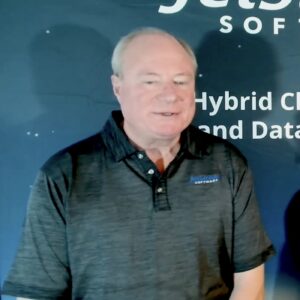|
|
 Rich Petersen presented for JetStream Software at Cloud Field Day 17 |
This Presentation date is June 1, 2023 at 13:30-15:00.
Presenters: Dennis Bray, Justin Jakowski, Prashant Desai, Rich Petersen, Serge Shats
Economic and Operational Advantages of Cloud DRaaS with JetStream Software
Watch on YouTube
Watch on Vimeo
Disaster Recovery (DR, or sometimes BC/DR) in the cloud can be more economical than legacy on-premises DR. JetStream Software’s Rich Petersen shows how storing recovery data and metadata in object storage and provisioning cloud-based compute nodes dynamically when needed can reduce the cost of DR infrastructure by 50% to 60%, making cloud a game-changer for DR. At the same time, by using VMware IO Filters (VAIO) to capture data immediately (no snapshots!) JetStream DR delivers a near zero Recovery Point Objective (RPO). Employing NetApp ANF to maintain data reduces Recovery Time Objectives (RTOs) to near-zero as well.
JetStream Software, led by co-founders Rich Peterson and Serge Shats, discusses the reasons why organizations are increasingly turning to the cloud for their disaster recovery (DR) needs. The cloud offers significant advantages in terms of cost and operational performance for DR strategies. JetStream DR, a cloud-based solution, can protect both on-premises workloads and those already migrated to the cloud. It provides failover capabilities, enables restoration of on-premises environments, and allows for the recovery of earlier points of consistency as required. JetStream’s cloud-native approach includes self-service capabilities, integration with cloud vendors’ marketplaces, and a focus on near-zero Recovery Point Objectives (RPOs) and Recovery Time Objectives (RTOs). The solution utilizes VMware IO Filters to capture and replicate data in real-time, ensuring minimal data loss. By leveraging economical cloud storage and dynamically provisioning compute nodes, organizations can achieve significant cost savings of around 50% to 60% compared to traditional DR approaches. The ability to maintain high application performance without interrupting operations is another key benefit. Finally, JetStream emphasizes the importance of visibility and control for administrators in a cloud-based DR solution.
Personnel: Rich Petersen, Serge Shats
JetStream DR Solution Architecture: Achieving both Performance and Cost Savings
Watch on YouTube
Watch on Vimeo
JetStream Software Senior Solutions Architect Dennis Bray presents the unique design of the JetStream DR platform, capturing data immediately as its written to storage, and replicating it as objects to a container in any standard object store, including Microsoft Azure Blob Storage. This enables the most cost- efficient near-zero RPO solution for DR in the cloud. Dennis shows that everything needed to fully recover a set of protected virtual machines (VMs) is in the object store. If desired data can be continuously replicated from the object store to storage in the recovery environment, for a near-zero Recovery Time Objective (RTO).
In this discussion, Dennis Bray from JetStream Software provides an overview of their architecture and proceeds to demonstrate its functionality. He begins by describing the components and technologies involved in their system. The core architecture includes a management server appliance that orchestrates and operates the software, which can be accessed through a vSphere client plugin or APIs for automation and integration. They also utilize IO filters to capture storage traffic and a DR virtual appliance (DRVAs) for processing and replicating data to an object store, such as an Azure storage account. The protected virtual machines, along with their configurations and status information, are stored in the object store, allowing for recovery in the event of a disaster. Dennis explains two recovery options: a standard failover with a longer recovery time objective (RTO) and a near-zero RTO option. The standard failover involves setting up a recovery site, deploying the software, configuring DRVA, and transferring ownership of the protected domain to the recovery site. Once completed, the failover process can be initiated, enabling the recovery of protected virtual machines. The near-zero RTO option requires a preconfigured and running recovery site, where virtual machines can be quickly recovered using the stored data and configurations from the object store. The discussion also addresses some questions from the audience, clarifying aspects such as the need for a live vCenter environment, the responsibility of customers in preparing the recovery site, and the compatibility of different object storage targets.
Personnel: Dennis Bray
JetStream DR in Action! Live Demonstration of JetStream DR on Microsoft Azure VMware Solution
Watch on YouTube
Watch on Vimeo
Get hands-on with JetStream DR on AVS, as JetStream Software Senior Solutions Architect Dennis Bray shows failover of three different VMware clusters from an on-prem Software Defined Data Center (SDDC) in San Jose to a Microsoft AVS data center in Sweden. In just a few minutes, virtual machines (VMs) that have “crashed” in San Jose are up and running in the Microsoft AVS environment. Dennis runs three different failover scenarios to show the range of options for DR using a single DR software platform, including the most cost- effective scenario in which data is stored exclusively in Microsoft Azure Blob Storage and the most high-performance scenario that leverages the performance and scalability of Azure NetApp Files.
In this demo by Dennis Bray of JetStream Software, he showcases the recovery process using JetStream’s solution. The protected site is located in San Jose, within the Equinix Data Center, running a small VMware environment. The virtual machines are replicated to an Azure VMware solution private cloud in the Sweden central region. The demo demonstrates both the near-zero Recovery Time Objective (RTO) option and the on-demand option. Three domains are set up with different configurations, including continuous rehydration and replication to different storage accounts. During the demo, Dennis imports the third domain and initiates the failover process. The progress of the failover and rehydration is shown, and the virtual machines are restored onto an Azure NetApp Files (ANF) data store. The demo also includes configuration settings, network mapping, and the use of JetStream’s automation toolkit for managing the recovery process.
Personnel: Dennis Bray
JetStream Enables DR of Virtual Machines to Microsoft Azure
Watch on YouTube
Watch on Vimeo
JetStream DR on AVS allows failover from on-prem VMware clusters to Microsoft’s Azure VMware Solution (AVS), a software-defined data center built on bespoke hardware in Azure data centers. It utilizes VMware’s vSAN for storage, NSXT for networking, and ESXi on physical servers, with management through vCenter. AVS is primarily used for cloud migration, data center extension, and disaster recovery, and JetStream Software is a critical component of DR to AVS. AVS provides performant all-flash storage with deduplication and compression. Networking is connected to Azure via an internal dedicated express route circuit, with global reach for on-premises replication. The solution offers high throughput for migration and replication, and can connect to Azure services like Azure NetApp Files through express route gateways.
Personnel: Justin Jakowski
Empowering Enterprise Disaster Recovery with JetStream Software and Microsoft Azure NetApp Files
Watch on YouTube
Watch on Vimeo
Prashant Desai, product manager at NetApp for Azure NetApp Files, discusses the partnership between NetApp and JetStream Software, highlighting the value it brings to customers. JetStream’s unique technology, including continuous data protection with near-zero recovery point objectives (RPOs) and recovery time objectives (RTOs), aligns perfectly with the requirements of NetApp’s enterprise customers using Azure NetApp Files (ANF) for business-critical workloads. By integrating JetStream’s solution, customers can leverage ANF for disaster recovery from on-premises Azure VMware Solution (AVS) environments with stringent RTOs. Additionally, the solution can be used for standard DR scenarios where RTOs are not as critical. ANF’s performance tiers offer flexibility and cost optimization, allowing customers to choose the appropriate tier for continuous rehydration and adjust performance levels as needed during a DR event. This collaboration provides customers with a comprehensive DR solution within Azure, supporting AVS private clouds and minimizing infrastructure costs.
Personnel: Prashant Desai










